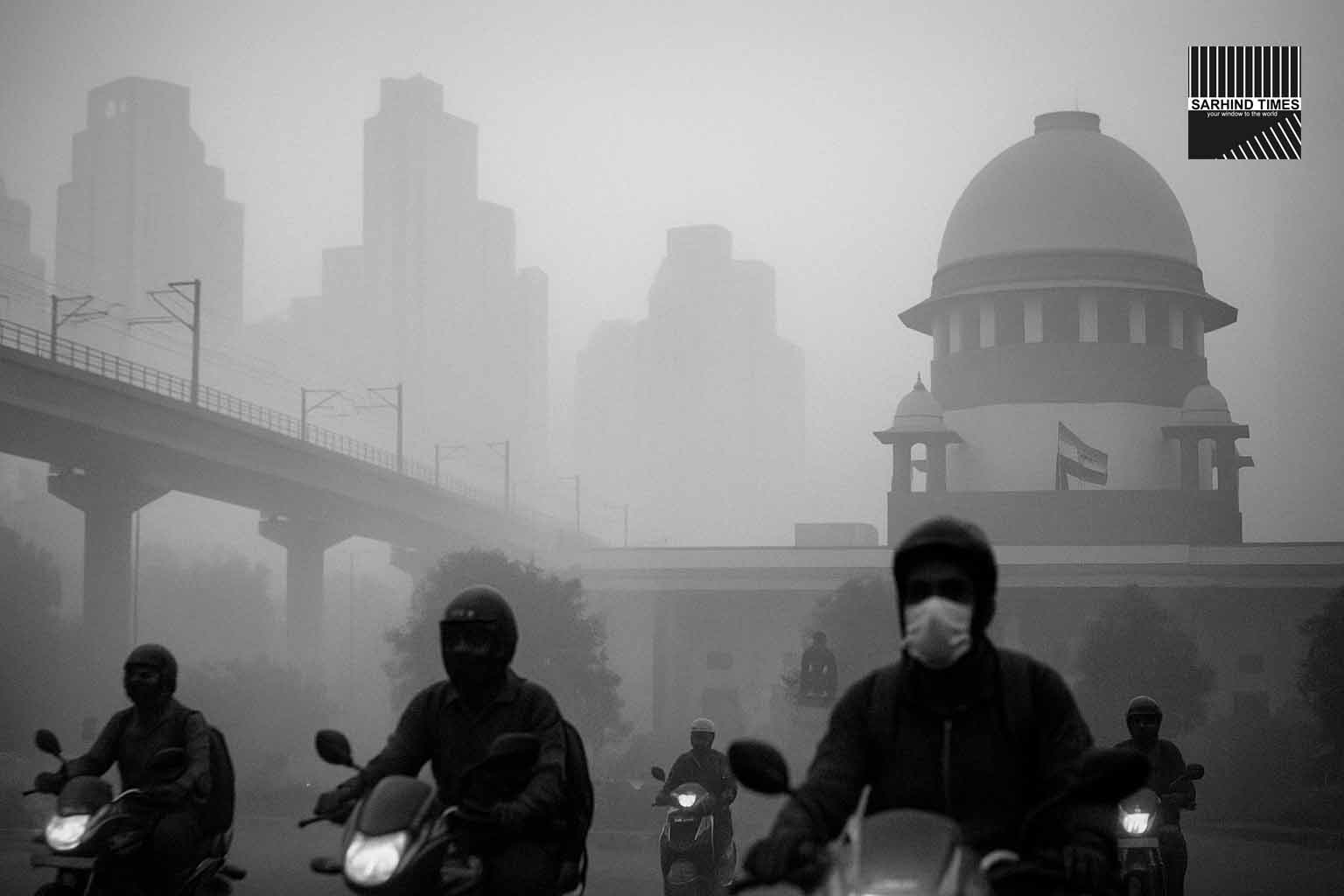City braces for early smog season as GRAP Stage-1 measures reactivated across NCR
(By Sarhind Times Environment Desk | Gurugram | October 16, 2025)
Gurugram — The Smog Season Arrives Early
Gurugram woke up to a grey skyline and a sharp deterioration in air quality on Wednesday, with the city’s Air Quality Index (AQI) climbing 16% in just 24 hours. Average readings surged from 216 (‘poor’) to 251 (‘very poor’), as stagnant winds, dipping temperatures, and mounting emissions combined to choke the atmosphere ahead of winter.
Environmental monitors at Sector 51, Gwal Pahari, Vikas Sadan, and Palam Vihar reported the steepest spikes, crossing the 300-mark in evening hours, prompting authorities to re-enforce Stage-1 actions under the Graded Response Action Plan (GRAP).
“This early surge is worrying. Calm conditions and residual humidity have trapped pollutants close to the surface,” said Anumita Roychowdhury, Executive Director at the Centre for Science and Environment (CSE). “If meteorological support doesn’t come, the curve could steepen rapidly by month-end.”
Meteorology and Mechanics: Why the Air Turned Sour
Experts attribute Gurugram’s latest smog spell to a perfect storm of meteorological and man-made triggers:
- Temperature inversion — Cooler nights prevent vertical mixing, locking particulates near the ground.
- Calm surface winds (below 5 km/h) — Limit dispersion of vehicular and industrial emissions.
- Construction and road dust — Major contributors in the city’s fast-expanding suburbs.
- Vehicular density — Over 1.6 million registered vehicles, many diesel-run, amplify the load.
- Regional spillover — Pollutants drift from neighboring Delhi and Haryana industrial belts.
The India Meteorological Department (IMD) has forecast further stagnation till Friday, with a brief chance of improvement if north-westerly winds pick up speed over the weekend.
Numbers Tell the Story
| Monitoring Station | AQI (Oct 14) | AQI (Oct 15) | Category |
| Sector 51 | 225 | 279 | Very Poor |
| Vikas Sadan | 210 | 248 | Poor → Very Poor |
| Gwal Pahari | 230 | 266 | Poor → Very Poor |
| Palam Vihar | 204 | 243 | Poor |
| Manesar Industrial | 219 | 260 | Poor → Very Poor |
(Source: Haryana State Pollution Control Board & CPCB Dashboard)
The citywide average of 251 pushes Gurugram into the ‘very poor’ threshold for the first time this season, weeks earlier than the usual November onset.
Civic Response: GRAP Stage-1 in Force
Following the spike, the Commission for Air Quality Management (CAQM) reaffirmed Stage-1 measures under GRAP, applicable across the National Capital Region (NCR).
Key directives include:
- Mechanized road sweeping and intensified water sprinkling on dusty corridors.
- Strict enforcement against open construction and debris dumping.
- PUC verification drives for commercial and private vehicles.
- Ban on DG sets in non-emergency use (except with approved retrofits).
- Awareness campaigns in RWAs and schools on clean air behavior.
Municipal teams were seen operating sprinklers along Golf Course Road and Sohna Road, while traffic police increased checks on heavy vehicles entering from the Kherki Daula toll plaza.
“We are coordinating with MCG, HSPCB, and the Traffic Department to ensure full compliance,” said Deputy Commissioner Nishant Yadav. “Residents must support enforcement through civic responsibility.”
Public Health Advisory
Medical practitioners have warned that even short-term exposure to current particulate levels can trigger respiratory distress, especially among children, the elderly, and those with pre-existing heart or lung conditions.
“AQI above 200 increases hospital visits for asthma and bronchitis,” noted Dr. Reema Bansal, pulmonologist at Medanta Hospital. “Masks with N95/N99 filtration, indoor air purifiers, and hydration are practical defences.”
The Health Department has advised limiting outdoor exercise during early mornings and late evenings when pollution peaks. Schools have been asked to re-schedule sports activities and ensure indoor ventilation.
Voices from the Ground
Commuters on MG Road and Sohna Road reported visibility drops during rush hours.
“The air smells burnt again,” said Rajesh Malik, a resident of Sector 47. “We had some clear weeks in September, but now you can feel the haze settling by evening.”
Cab drivers and delivery workers expressed concern over prolonged outdoor exposure without protective gear. NGOs like Clean Air Collective Gurugram distributed masks and leaflets explaining grievance-reporting channels through the Green Gurugram mobile app and MCG helpline 1800-180-0172.
Crop Burning and Festive Fireworks: The Next Wave
Satellite data from the Indian Agricultural Research Institute (IARI) show early stubble-burning incidents in parts of Punjab and Haryana — up 22% from the same period last year. Prevailing north-westerly winds are expected to carry these plumes into Delhi-NCR.
Environmentalists fear a double impact if Diwali fireworks coincide with stagnant air layers.
“Even two calm days with residue smoke can tip AQI into ‘severe’,” warned Sunita Narain, CSE Director-General. “We must enforce crop management subsidies and community firework alternatives aggressively.”
Policy and Accountability
Gurugram’s Air Quality Management Cell, launched last year, is tasked with tracking local sources and coordinating responses among departments. Critics, however, say implementation remains inconsistent.
“We have strong frameworks like GRAP and NCAP, but weak execution,” said Anirudh Ghosh, an environmental lawyer. “What’s missing is real-time accountability—who gets fined, how much, and where that money goes.”
Civic data shows that between April and September 2025, the MCG issued 1,540 challans for dust-related violations but collected fines in only 60% of cases.
The Economics of Pollution
Poor air quality has direct economic costs — from reduced labor productivity to healthcare expenditure. A 2024 study by the Energy Policy Institute at the University of Chicago (EPIC) estimated that NCR residents lose up to 9.7 years of life expectancy if current pollution levels persist.
Real estate consultants note that air quality also affects property valuations and tourism. In October, Gurugram’s hotel occupancy fell 6% week-on-week, attributed partly to deteriorating air and travel advisories from embassies.
Citizen Action and Community Innovation
Despite grim headlines, several local groups are taking initiative:
- Eco Club Gurugram launched the “Adopt a Road” drive for weekly clean-ups.
- DLF Foundation initiated a pilot for bio-enzymatic dust suppression around construction sites.
- RWAs in Sushant Lok are experimenting with vertical green walls to absorb particulates.
“Clean air isn’t only the government’s job—it’s everyone’s,” said RWA convenor Kavita Taneja. “Small community actions can collectively make a measurable impact.”
Expert Outlook: The Road Ahead
Meteorologists predict that AQI could oscillate between ‘poor’ and ‘very poor’ through early November unless western disturbances bring wind relief.
The Central Pollution Control Board (CPCB) will review the situation this weekend, with a possibility of escalating to GRAP Stage-2 if daily averages cross 300 for three consecutive days.
“Stage-2 would mean restrictions on diesel vehicles, brick-kiln operations, and generator usage,” explained Arvind Kumar, regional pollution officer. “Our aim is to prevent reaching that threshold.”
Long-Term Measures Underway
The Haryana government has rolled out several mid-term mitigation efforts:
- Electric bus corridors under the NCR Air Plan (Phase II).
- Paver block retrofitting on dusty arterial roads.
- Real-time air monitoring expansion to 25 new micro-stations.
- Greening drive targeting one lakh saplings by February 2026.
Officials say the upcoming Integrated Command-and-Control Centre (ICCC) in Sector 44 will allow better coordination of traffic, construction, and sanitation data to predict pollution surges in advance.
Educational Campaigns and Awareness
Schools and colleges are incorporating clean-air modules into environmental studies. The District Education Office has directed institutions to observe Clean Air Week (Oct 20–26), featuring workshops, cycling rallies, and mask-distribution drives.
“Behavioral change is the most powerful antidote to air pollution,” said District Education Officer Meenakshi Arora. “If children start questioning burning waste or idling cars, adults will follow.”
Comparative Lens: Gurugram vs Delhi vs Noida
| City | Oct 15 Avg AQI | Dominant Pollutant | GRAP Stage |
| Delhi | 263 | PM 2.5 | Stage-1 Active |
| Gurugram | 251 | PM 2.5 + Dust | Stage-1 Active |
| Noida | 244 | PM 2.5 | Stage-1 Active |
Analysts say Gurugram’s readings often trail Delhi by just 5–10%, but its industrial periphery and construction density make local mitigation more challenging.
The Human Cost: Stories Beyond the Data
At a city hospital, 11-year-old Aarav lay connected to a nebulizer — his third visit this month. His mother, an office worker, says their air purifier runs 24 hours a day.
“We can’t see stars anymore,” she says quietly. “Every October feels like punishment.”
Stories like Aarav’s echo across the NCR, reminding policymakers that air pollution is not just an environmental crisis — it’s a public health emergency.
Conclusion: The Air We Breathe, the Choices We Make
As Gurugram’s skyline fades into haze, the challenge before its 1.5 million residents is both collective and moral: to treat clean air not as a privilege but as a right secured through shared responsibility.
Without sustained enforcement, civic discipline, and public cooperation, every winter will bring the same grim cycle — grey mornings, smart masks, and headlines of inaction.
The city’s future, experts warn, will depend not on how fast it grows upward, but on how cleanly it breathes forward.
#Gurugram #AQI #AirPollution #GRAP #CleanAir #NCR #Environment #Health #Sustainability #ClimateCrisis #Haryana





















+ There are no comments
Add yours